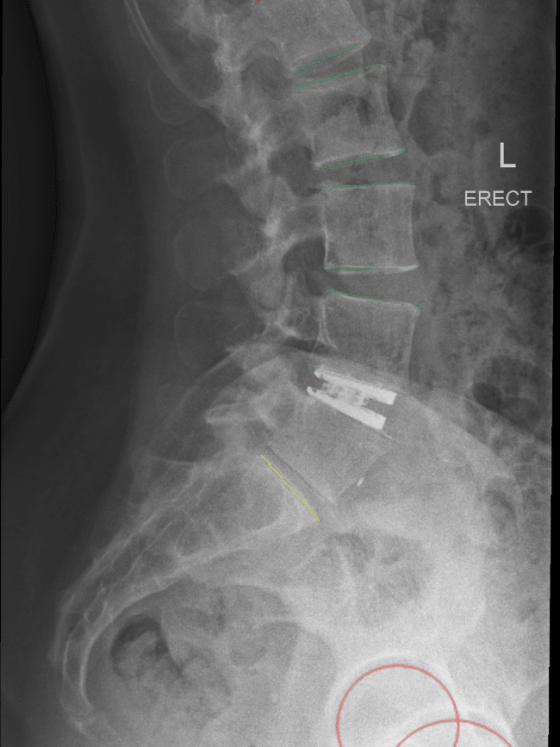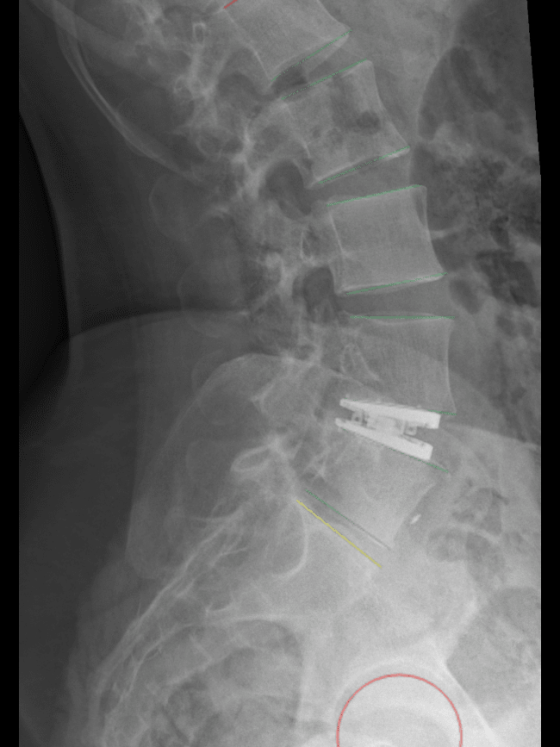Lumbar Disc Replacement
Lumbar Disc Replacement is a surgical procedure designed to treat mechanical lower back pain that is emanating from the disc itself, and hasn’t responded well to conservative treatments. It involves removing a damaged or degenerated disc in the lumbar spine (the lower part of your spine) and replacing it with an artificial disc.
What are the Potential Benefits of Lumbar Disc Replacement?
When comparing lumbar disc replacement to lumbar spinal fusion, several potential benefits might make disc replacement a preferable option for certain patients. Here’s a breakdown of the proposed advantages:
Preservation of Motion
Disc Replacement: One of the primary benefits is that it preserves the natural movement of your spine. The artificial disc is designed to mimic the function of a natural disc, allowing your spine to maintain its flexibility and range of motion.
Fusion: Spinal fusion, on the other hand, eliminates movement at the fused segment by permanently joining two or more vertebrae together. This can limit flexibility in that part of the spine.
Reduced Risk of Adjacent Segment Disease
Disc Replacement: Because the motion is preserved, there’s a potentially lower risk of adjacent segment disease. This condition occurs when the segments of the spine above or below a fusion site undergo increased stress, leading to degeneration and new symptoms over time.
Fusion: By limiting movement, fusion can place additional stress on the adjacent vertebrae, potentially accelerating degeneration in those areas.
Faster Recovery
Disc Replacement: Recovery from disc replacement surgery may be faster compared to fusion because the procedure is performed via an anterior approach and the muscles in the back are not damaged.
Fusion: Recovery from fusion by some techniques can be slower, and patients often require a longer period of immobilization or restricted activity to allow the bones to fuse properly.
Potentially Lower Risk of Long-Term Complications
Disc Replacement: Since disc replacement allows for continued movement, it may result in fewer long-term complications related to stiffness, reduced mobility, or the need for additional surgeries. The proposed advantage of Disc Replacement is to reduce the risk wearing out the disc above or below the replaced disc (adjacent segment disease).
Fusion: Fusion can lead to long-term complications such as chronic pain, stiffness, or the need for future surgeries due to problems in adjacent segments or non-union (where the bones don’t fuse as expected).
Pain Relief
Disc Replacement: Both disc replacement and fusion are effective at relieving pain. However, disc replacement may provide better functional outcomes in terms of movement and flexibility, contributing to a more natural feeling spine.
Fusion: While fusion also provides pain relief, it comes with the trade-off of reduced spinal mobility.
Avoidance of Bone Grafting
Disc Replacement: Disc replacement typically doesn’t require bone grafting, which is often needed in fusion surgeries. Bone grafting involves using bone from another part of your body or a donor, which can introduce additional risks and complications.
Fusion: Fusion surgery usually requires bone grafting to facilitate the fusion of the vertebrae, adding another layer to the procedure and potential recovery challenges.
Future Treatment Options
Disc Replacement: Since disc replacement preserves movement, it may keep more options open for future treatments if needed.
Fusion: Once the spine is fused, it cannot be undone, which can limit future treatment options if new spinal issues arise.

Standing X-Ray (Side View)

Forward Bending X-Ray (Side View)

Backwards Bending X-Ray (Side View)
Why is Lumbar Disc Replacement Controversial?
Lumbar disc replacement is considered controversial for several reasons, primarily related to the complexity of the procedure, the variability in patient outcomes, and the long-term effectiveness and safety of the artificial discs. Here’s a breakdown of the main points of controversy:
Long-Term Outcomes and Durability
- Uncertain Longevity: One of the biggest concerns with lumbar disc replacement is the long-term durability of the artificial disc. While some patients experience good outcomes, others may face complications as the disc wears out over time. The long-term success rates are still being studied, and there’s uncertainty about how well these discs will function 10, 20, or more years after implantation.
- Potential for Revision Surgery: If the artificial disc fails, or causes issues later on, revision surgery might be necessary, which can be more complex and challenging than the initial procedure. Removal of the artificial disc can be hazardous and obtaining fusion at the level replaced can also be difficult in these revision scenarios.
Patient Selection Criteria
- Not Suitable for All Patients: Lumbar disc replacement is not appropriate for everyone. The ideal candidates are typically younger, active individuals with isolated disc disease and no significant facet joint arthritis or spinal instability. However, many patients with chronic back pain have multiple issues, making them less suitable for this procedure.
- Complex Diagnosis: Accurately diagnosing who will benefit from disc replacement can be challenging. Misdiagnosis or unclear patient selection can lead to suboptimal outcomes, making the procedure less predictable.
Technical Challenges and Surgical Expertise
- Complex Procedure: The surgery itself is technically demanding and requires significant expertise. Accessing the lumbar spine through the abdomen involves navigating around major blood vessels and other vital structures, increasing the risk of complications during surgery.
- Surgeon Experience: The success of lumbar disc replacement is highly dependent on the skill and experience of the surgeon. Inexperienced surgeons might have higher complication rates, which contributes to the controversy surrounding the procedure.
Complication Risks
- Device-Related Issues: There is a risk that the artificial disc might not function as intended, could dislodge, or cause adjacent segment disease (although this is less common than in fusion). Additionally, there may be metal sensitivity or allergic reactions in some patients, though this is very rare.
Comparative Effectiveness vs. Fusion
- Inconsistent Outcomes: Some studies suggest that lumbar disc replacement might not offer significantly better outcomes than spinal fusion in certain patients, which leads to debate over whether the added complexity and risks of disc replacement are justified.
- Cost-Effectiveness: Given the uncertainty around mid-term and long-term benefits, there is ongoing debate about whether the higher costs of lumbar disc replacement are justified compared to fusion, which is a more established and understood procedure.
Regulatory and Market Issues
- Varying Availability and Approval: The availability of lumbar disc replacement varies by country and region due to differences in regulatory approvals, insurance coverage, and clinical guidelines. In Australia, multilevel disc replacement is not reimbursed by Medicare or insurers, and instead Hybrid fusion and replacement may be performed.
- Changes in Device Technology: Throughout the evolution of lumbar disc replacement, different designes of artificial discs have been developed and some have been withdrawn from the market due to complications or poor outcomes (eg Charite). This ongoing evolution in the technology adds to the uncertainty and controversy surrounding the procedure. A/Prof Buckland tracks the results of all lumbar disc replacements he performs, including contributing to the Australian Joint Registry.
Lack of Consensus in the Medical Community
- Divergent Opinions: There’s a lack of consensus among spine surgeons and other medical professionals about when lumbar disc replacement should be used. Some view it as a valuable option for certain patients, while others are more cautious, preferring fusion or other treatments.
Summary
Lumbar disc replacement remains controversial due to concerns about long-term outcomes, patient selection, surgical complexity, and comparative effectiveness. While it offers potential benefits, these factors contribute to the ongoing debate within the medical community about its overall role in the treatment of chronic lower back pain.
What is involved in Lumbar Disc Replacement Surgery?
The lumbar spine consists of five vertebrae, each surrounded by a soft, cushion-like disc. These discs act as shock absorbers, helping the spine move smoothly and keeping it flexible.
Sometimes, these discs can wear out, become damaged, or degenerate due to age, injury, or conditions like arthritis. When this happens, it can cause significant pain, stiffness, and other symptoms like numbness or weakness in your legs.
What Happens During the Surgery?
- Preparation: You will be given general anesthesia, so you will be fast asleep, and won’t feel any pain during the surgery.
- Accessing the Spine: The disc is accessed via the abdomen (anterior approach) with the assistance of a Vascular Surgeon. This approach avoids cutting through the muscles of your back, but involves mobilizing blood vessels at the front of the spine.
- Removing the Damaged Disc: A/Prof Buckland carefully removes the damaged disc. Any compression is removed from the adjacent nerves, and the disc is freed up to restore its normal height.
- Inserting the Artificial Disc: An artificial disc, which is made of metal, plastic, or a combination, is then inserted into the space where the damaged disc was removed. This new disc is designed to mimic the function of a natural disc, allowing your spine to move mor naturally. The optimal position of the disc is confirmed by taking X-rays during the surgery.
- Closing the Incision: Once the disc is in place, and X-rays performed, the incision is closed with dissolvable sutures, and you’ll be taken to the recovery room.
*Artificial Disc Replacement is shown below with movement through the lumbar spine
Postoperative Recovery
- Hospital Stay: You’ll likely stay in the hospital for 1-2 days after the surgery.
- Outpatient Rehabilitation: Physiotherapy is usually recommended to help you regain strength and flexibility in your spine. This typically starts at 2-weeks after surgery. You will be advised to avoid bending, lifting and twisting activities for the first 3-months after surgery, and then gradual return to regular activities can be performed thereafter.
- Pain Relief: Many patients experience significant pain relief after the surgery, although full recovery can take several weeks to months. Medications are typically required for postoperative pain for the first 2-4 weeks.
Benefits and Risks
- Benefits: The main benefit of lumbar disc replacement is pain relief and improved mobility. Unlike spinal fusion, another treatment option, disc replacement allows for more natural movement of your spine.
- Risks: As with any surgery, there are risks, including infection, blood clots, or problems with the artificial disc. A/Prof Buckland will discuss these risks with you in detail before the procedure, including those specific to the anterior approach to the spine.
This surgery is often recommended if other treatments like physical therapy, medications, or injections haven’t provided enough relief. It’s important to have a thorough discussion with A/Prof Buckland to understand if this is the right option for you. To learn more about A/Prof Buckland’s results of lumbar disc replacement, click here.

